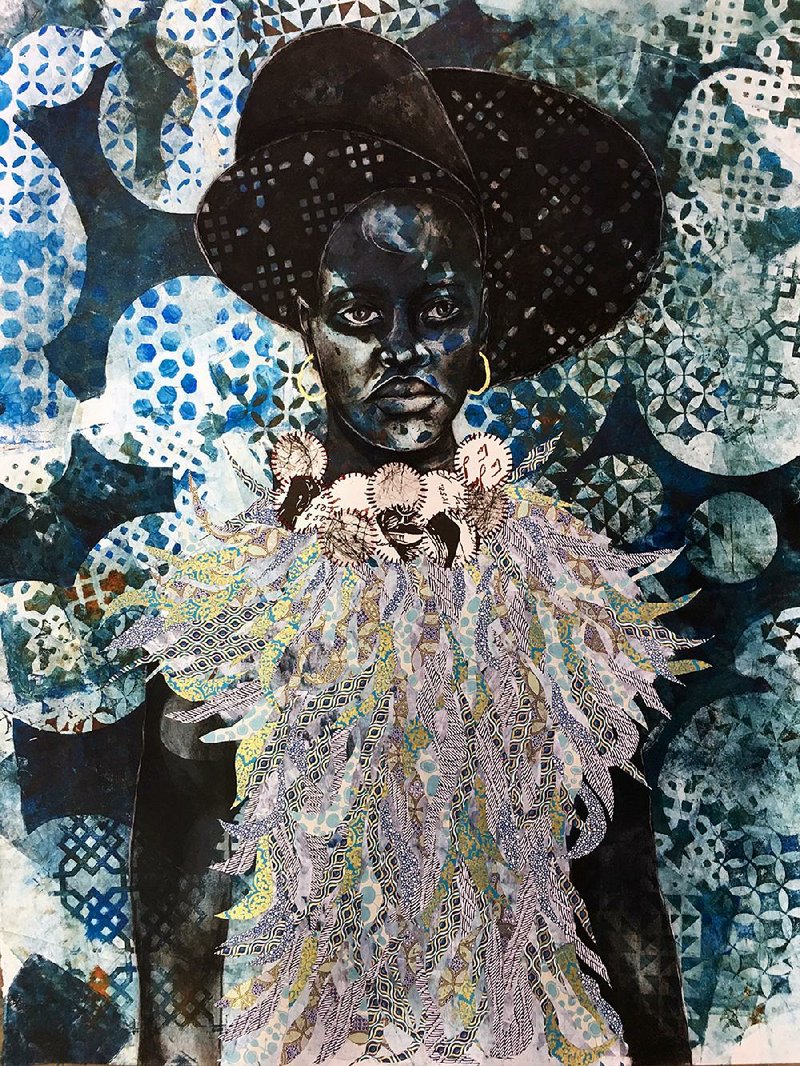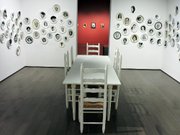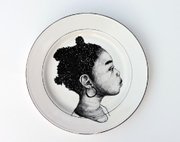Mixed-media artist Delita Pinchback Martin, whose life and art are rooted deeply in her family's matriarchal storytelling and creativity, is a time-traveler.
An exhibition of her work, which presents black women in transformative, folkloric and cultural settings, is always a welcome event.
Art of Delita Pinchback Martin
Through Oct. 9, Bradbury Art Museum, Fowler Center, Arkansas State University, 201 Olympic Drive, Jonesboro
Hours: noon-5 p.m. Tuesday-Saturday, 2-5 p.m. Sunday
Admission: Free
(870) 972-3471
So if one exhibit's good, how about three?
That's what viewers get at the Bradbury Art Museum at Arkansas State University at Jonesboro through Oct. 9, where the former Little Rock resident offers a look at her past, the present and points to the future.
Her new, large-scale mixed-media works, "Night Women," hang in one gallery. Here, she continues her exploration of layering lithography, hand-stitching, decorative papers, collage, drawing, painting and more in an ever-expansive, deeply spiritual vision that examines the complexities around ideas of race, gender, roles and beauty. A second gallery is devoted to works from "I Walked on Water to My Homeland," her exhibit from earlier this year at the Mosaic Templars Cultural Center in Little Rock.
But it is Martin's first art installation in a third gallery that is certain to turn heads. "Dinner Table" consists of 200 drawings of black women on dinner plates arranged on white gallery walls. At the center, a white table with six chairs welcomes viewers to sit down and take it all in.
"The dinner plates started with me representing family members," she says. "I started thinking about what family really meant, so I had to include my extended family. We never know the impression we leave on people with a hug, a hello, a conversation. ... I recall conversations that may have only lasted a minute, but I still remember them. I have had short interactions with all of these folks.
"So what would it be like to be in a space with all of these women at one time?"
That thought shaped "Dinner Table." Martin looked to other artists, particularly Judy Chicago's The Dinner Party, a massive sculptural banquet arranged on a triangular table with 39 place settings representing important women from history, and the intense "The Kitchen Table Series" of black-and-white photographs by Carrie Mae Weems.
The dining room has been traditionally seen as a woman's domain, and Martin says she wanted to transform it into a place of prayer and joy -- a place where women meet to share ideas, tell stories and support one another.
"Carrie has an intimacy I'm drawn to, very personal and universal; hers is a domestic space with different situations that could [affect] a person's life," Martin says. "Judy Chicago's work was monumental in the feminist arena, very powerful. I wanted to add to the conversation; I felt like her work was finite, closed off. The dinner table was set. I wanted to bring past, present, future into one space.
"We included a table, with six chairs, to invite people to sit there and join the conversation; be a part of it. It's a powerful space for meditation."
Martin was deeply moved when she saw the 200 plates hanging together for the first time.
"I cried a bit, seeing all the work in one place," she says. "I talked with Les [Christensen, director of the Bradbury] about the installation. Seeing someone pull something out of your heart and mind the way she did was amazing; it was beyond anything I had imagined."
Martin worked on the plates over a 2 1/2 year period; 200 of the 300 she completed are on display. She hopes the installation will travel to other museums.
"Powerful is the first word that comes to mind," Christensen says of Martin's work. "Also inspirational and moving."
Christensen says she had several conversations with the artist about how Martin felt the plates should be hung: "She asked for my opinions; we talked back and forth and came up with a plan. It's a little like magic, the plates went where they needed to go. It was one of those times the project just took over."
So, who are these women on the walls? Along with family, extended family and friends, Martin took photos of people and used social media to explore connections with, and among, women for inspiration.
"I wanted to include women who weren't necessarily written about in history, but could be," she says. "The women who nurtured those who did the first of anything ... I wanted to put them in a place of honor."
Martin's artwork is in half of the Bradbury's six galleries and is the first show since the museum was redesigned and rebuilt over the summer. At the Bradbury's other galleries are "Arkansas Neighbors," an exhibit from the museum's permanent collection of photographs by Arkansas photographer Andrew Kilgore; "Seat Assignment: Lavatory Self-Portraits in the Flemish Style" by renowned photographer Nina Katchadourian; and "Continual Myth," a series of drawings by Memphis resident Tad Lauritzen Wright.
Three galleries devoted to Martin's art suggest a retrospective of sorts, but she sees it through a bigger lens. "This gives you a progression of my work. It's what the work was, what it is now and what it will be."
Martin's career took a major leap during her Arkansas residency. (She and husband Cedric Martin moved to the state in 2008, then to Houston in 2015.) But that leap didn't come without a struggle. After successful shows in 2013 at Boswell Mourot Fine Art (the gallery still represents Martin) in Little Rock, she said she had reached a pivotal point in her career.
"That time period was really crazy; it was a hard moment," she says. "I had stopped teaching and I was trying to figure out where I was as an artist, if this was going to work. I hadn't found my voice, I didn't know what to do.
"So I got in the studio and shut everything, everybody out ... and created. I didn't ask anyone's opinion; I didn't want the feedback. I had to let it play out, I had to just work. Every day I would sit down before I went into the studio and tell myself: 'You are an artist and you can create by any means necessary.' That changed my life, opened up my work, took my work beyond what I thought I could be."
The work that emerged from that period -- larger than life, charged and mystical multimedia layered works of black women inspired by her family's storytelling -- was shown at the Arts and Science Center for Southeast Arkansas in Pine Bluff in summer 2014.
That exhibition, "I Come From Women Who Could Fly," was her breakthrough.
That body of work led to her inclusion in Crystal Bridges Museum of American Art's exhibit of emerging American contemporary artists -- "State of the Art: Discovering American Art Now." She was one of four Arkansas artists in the exhibition.
...
The works of "Night Women," such as her pieces in "I Come From Women Who Could Fly," are large in scale. Daughter of the Night, for example, is 50-by-39 inches.
"I love working large. I work on the floor, sitting in the middle of the work. I'm more comfortable that way. My entire being is part of the process of creating these works."
"Night Women," she says, is influenced by literature. The color blue in the works, she says, represents nighttime, a time or space for transformation.
"I listen to audio books, lectures, artist talks ... as I work. Some of the work has short stories, text written by me. Writing becomes a form of identity. I'm reading a lot of sci-fi books by Octavia Butler.
"I'm interested in these women [in the art] transitioning into the magical beings that women really are. There are no boundaries."
Email:
ewidner@arkansasonline.com
Style on 09/06/2016


